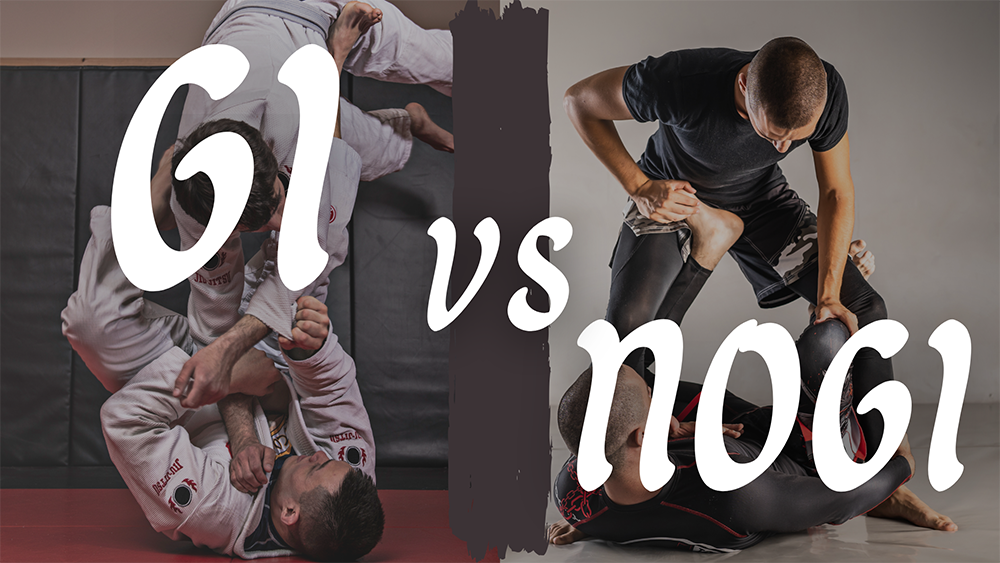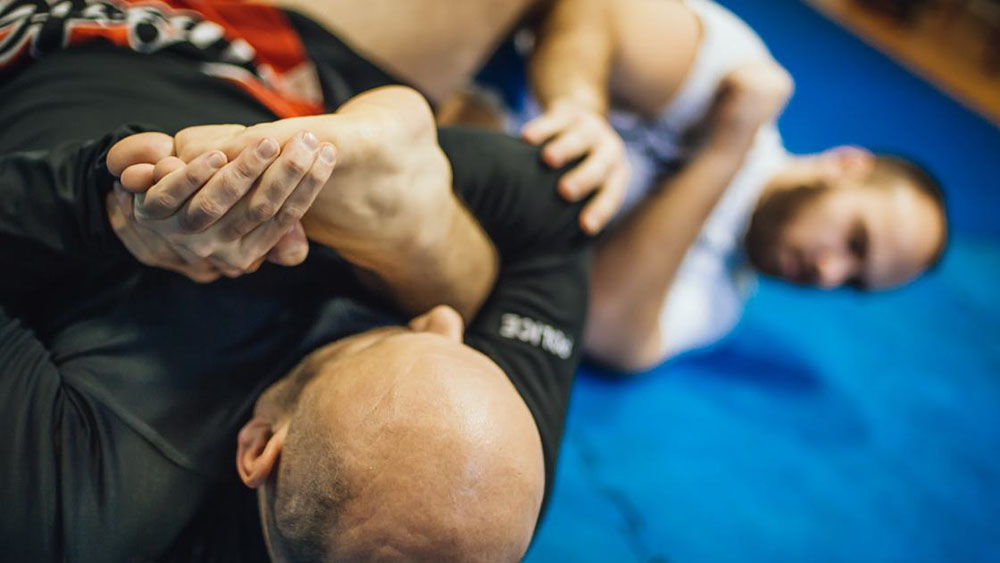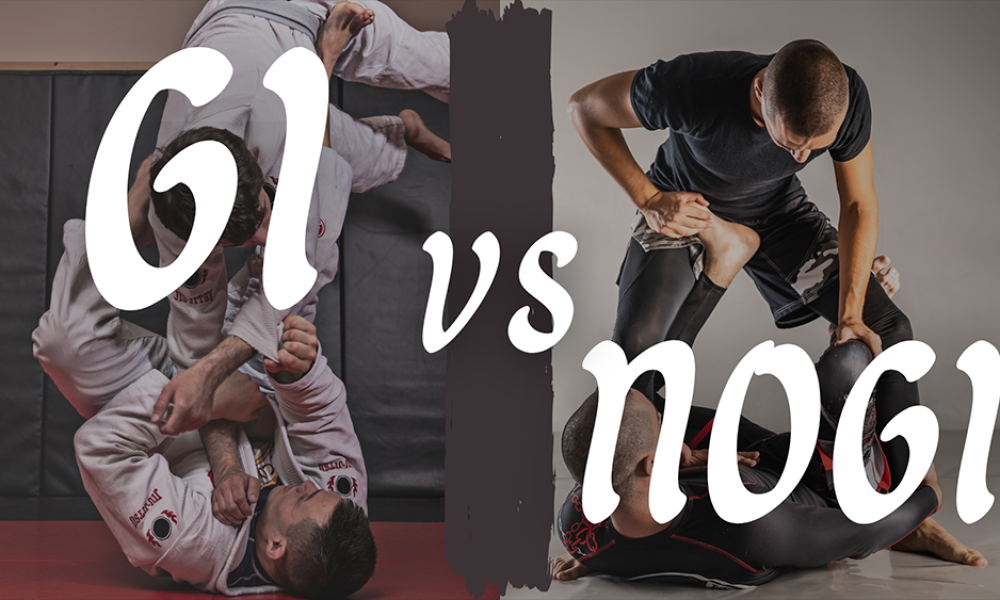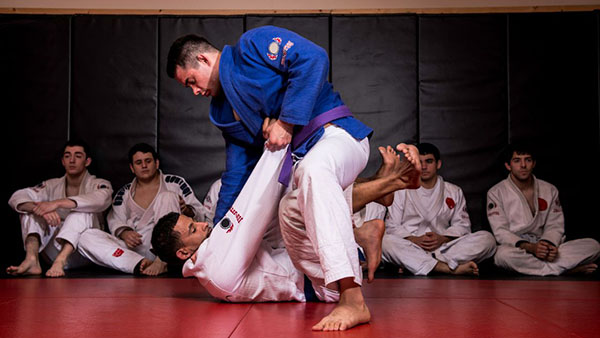Gi vs Nogi Jiu Jitsu and Why I Train Both
The title should really be Gi vs Nogi Jiu Jitsu, Why I Train Both and How I've Had My Mind Changed While Writing This Article but that's too long!
Quick note about spellings for all you pedants out there. I'm English and use UK spellings but some of my case studies who typed their replies to my questions are from North America so they used US spellings and that's why you will see both UK and US spellings throughout.

A Brief Explanation of Both Styles
Gi Jiu Jitsu involves practitioners wearing a kimono-like uniform known as a Gi. The Gi consists of a jacket and pants made from thick interwoven cotton and a belt, which indicates the practitioner's rank. Gripping the Gi is an essential aspect of this style. The fabric creates a lot of friction, soaks up a lot of sweat and generally makes movements slower and more difficult. The fabric itself can be used to set up chokes and other submissions.
Nogi Jiu Jitsu, as the name suggests, is practiced without the traditional Gi uniform. Instead, practitioners wear shiny short or long sleeved, tight fitting "rashguards" and shorts and some wear leggings or "spats" under or instead of shorts. There is no belt, though many Nogi only gyms still promote their students using the belt colour system and if competing a practitioner must often wear a rashguard with the predominant colour of their rank. The absence of grips on fabric plus the slipperiness of the sweat on skin and the often shiny fabric, significantly alters the dynamics of the sport. The action is usually much faster paced as the athletes slip and slide out of grips and try to hold on to body parts where there is no cloth to grip.
It's Too Late!
A 10th Planet purple belt friend of mine James Jones, came to our open mat yesterday and when a few guys turned up in Gis and a few of us were in Nogi gear, the Gi vs Nogi conversation started.
In case you don't know, 10th Planet is 100% Nogi only.
I met James on a Black Sheep Retreats camp in the summer, we bonded over note taking, coaching and Ecological Dynamics chat. At the open mat he said he's never put a Gi on before but at some point he would like to get into it. I laughed because I know this guy is a very dedicated student and coach, who also competes quite a bit. He's going pretty hard in the Nogi paint!
He's only in his 20's but I think it's too late for him to start Gi training and I'll explain why.
Jiu Jitsu is a lifelong pursuit. It takes many, many hours of physical practice and many hours of study too, consuming content and figuring stuff out.
The pay off is the wonderful feeling of progression. Sure there are times you feel you're plateauing or even going backwards, but that's usually down to the odd bad day or the fact that all the people you're training with are improving too, which makes it more difficult to recognise your own progress.
Generally though, most sessions you feel you're getting better and this feeling is very addictive. It pushes you to keep going and the more you train the better you get.
If you keep training you'll experience many breakthroughs and epiphanies and as your knowledge increases, your ability to take on new information and absorb and connect it, also increases.
If you've already dedicated several years of practice and study to either Gi or Nogi Jiu Jitsu, similar as they are in many ways, if you then decide to start training the other, you'll feel somewhat like a beginner again.
Stick with it and of course your learning curve will be much steeper than actual beginners but all the hours you're now putting into basic things, could be progressing the sport you're already competent in. As most people have a limited time to train, around work, family and other commitments, you might find it hard to justify.

Why Do I Train Both?
I've pretty much trained both Gi and Nogi almost from the start but it was a circumstantial choice rather than a conscious one.
I had a trial group class and about 15-20 private lessons over about 6 months back in 2012, all in a Gi. Then I paused training while I had a couple of hip operations and after about a year, when I was fit enough to start training again, I was living out in Asia and without my Gi so I started Nogi training instead. Soon enough after I found a Gi I trained both and from that point I can't remember a time when I preferred one over the other.
I love that I can switch between the two. I enjoy both for different reasons and I feel I've gained more from training in both than I would have if I'd only trained one or the other. Plus it has allowed me to take full advantage of any class schedule at any gym I've trained at, not just Gi or Nogi Jiu Jitsu but MMA, wrestling and Judo too.
Case Studies
I wrote all that ☝️ soon after James visited our gym and before I really started giving this subject some proper thought.
If there's one thing (and there really is only one thing) I can confidently say about Jiu Jitsu, it's that every single practitioner is having a very personal experience with their training and it's always worth asking others for their opinions and insights.
A great place to find thoughtful and intelligent Jiu Jitsu people is the BJJ Mental Models Discord server*. So aside from a couple of black belts I know personally, my old friend Richard Manson and my coach Leigh Remedios, the below "case studies" are all from the BJJMM Discord or another of my favourites Ecological Dynamics for Submission Grappling a free server anyone interested in the Ecological Approach can join.
*A feature only available when you pay for a Premium membership. Start with a free trial and see what other benefits there are, use my code TAMMI for 50% off your first 6 months and cancel anytime.
Gant Grimes
Gant is a 49 year old black belt who teaches at Red River BJJ in Wichita Falls, Texas. He trained in Kenpo, Japanese Jujitsu, Aikido, Taekwondo and then Judo in his 20's, all in a Gi. While training Judo he would often cross train with wrestlers and also sometimes have to wrap injured hands and train without grips. He started Brazilian Jiu Jitsu at 37 but it wasn't until he was teaching Gi BJJ as a purple belt that he started to take off the Gi and train and teach Nogi too.
"I wanted to diversify my skill set and I also wanted my students to 'grow up' well-rounded. I was also tired of washing Gis all the time."
I'm currently converting an old school bus into a home to travel around the grappling gyms of Europe and how I will manage the washing and drying of my Gi's is a genuine concern. Nogi gear is easy to hand wash, dries quickly and doesn't take up much space. Gi's require much more vigorous washing, take a long time to dry and are heavy and bulky.
Gant's classes are now almost exclusively Nogi, as voted for by his mostly older students.
"My students aren't that interested in competing, so I don't need to be married to a ruleset. I just teach them to grapple. It's basically a submission grappling approach with no technique restrictions.
Nogi Jiu Jitsu was traditionally looked on as less technical because it's harder to hold on to slippery people. In my opinion it's not that different at all."
His advice for beginners?
"I'd recommend training in both early on for two reasons, 1) the offensive/defensive aspects of the game change depending on the kit and those are important to experience and 2) because some people do specialize, you'll need to train both to access the full stable of training partners."
Listen to Gant talking about how Good Jiu Jitsu is like a Bad Marriage on the BJJ Mental Models podcast.
Working Dog
@working_dog is a 50 year old brown belt woman training in Australia and mostly trained Gi until just last year.
"Up to brown belt about 75% of my training was Gi. I’m comparatively old so the Gi gave me the ability to even the playing field by slowing down younger, more athletic opponents.
I’m now about 60% Nogi. This wasn’t deliberate, it was mostly related to schedule and preference of both myself and my coach. If I want training partners I’ve had to change my game as over time everyone else has transitioned to mostly Nogi due to the rise of ADCC & it’s far too hot in summer for most people to roll in a Gi."
Aaron Parham
Aaron started training when he was 22, firstly MMA so mainly Nogi, with two days a week in the Gi. He stopped doing MMA/Nogi once he was promoted to blue belt after almost a year and started training mainly Gi instead. After 13 years of mainly Gi only, a couple of years ago he switched again to training mainly Nogi.
During his Gi years he would sometimes compete Nogi but never specifically train for it but he still won a couple of local competitions in Nogi absolute divisions as a purple belt.
Now his training ratio is seasonal, half the year is Nogi (spring/summer) and the other half is a split schedule.
"The transition was difficult, but I slowly adapted to not having the affordances of the Gi. Now that I'm back in the Gi, I've realised my Gi game has dramatically improved from extensive Nogi training.
Personally, I think Gi should not be taught to beginners, they should start Nogi, then once experienced put on a Gi. It gives you additional affordances that only make sense once you understand grappling at a fundamental level, but trying to learn to grapple with the Gi on first can be frustrating. Learning to move, escape, and control someone without using the Gi is essential."
Matt Wild
Matt trains at Stealth BJJ in Bolton, UK. He's a 32 year old brown belt and started training in a Gi at 17 years old. He trained for three years before trying Nogi but now 95% of his training is Nogi.
"Transitioning to Nogi is considerably easier than transitioning to Gi. Gi gaslights the brain. In Nogi you have about a dozen key points of control, in Gi you have hundreds of points of control and depending on what and how you grab varies those points. Going from Gi to Nogi may seem easier in theory but in practice you're going to have considerably more aspects to work on. Because of how the Gi works you can control multiple key areas in one go, and then take your time building for better grips, whereas in Nogi someone can move their hip away an inch and you lose all your inside position and control. Gi gives you very niche control - Nogi gives you generic control."
When advising a beginner he says
"It's easy to adapt to the Gi. You've got to learn to not get blinded by the sparkly lights (all the grip locations) and learn to be patient. Nogi is grappling in its simplest and purest form. If I had to start from scratch I'd recommend against the Gi until you absolutely have to - and that might not ever occur."
Jess
Jess is a competitive blue belt who trains both Gi and Nogi at Guerrilla Jiu Jitsu Academy, Reno Nevada. She only trains one or the other if she's training for a specific rule set in competition, then her training switches to preparing for that competition.
"I like both. They each have connections and components to the other."
She recalls at a seminar she attended with Roger Gracie he was asked if he changed his game when it came to Gi or Nogi. He laughed and said “no because it’s all the same, why make it harder?”
"Sometimes my fingers need a break when training in the Gi so I use Nogi grips. Sometimes I want to focus on pins without Gi grips so I train Nogi because it reinforces concepts that are not Gi reliant.
When people ask which is better my response never changes, it’s whatever gets you excited and keeps you coming through the door.”
That last statement might just be the point that changed my mind more than any other.
Jeff Alexander
Jeff is a 53 year old competitive purple belt training at Renzo Gracie Academy in New York and also Sheridan BJJ in New Jersey.
His reasons for initially switching from Gi to Nogi are mostly practical and scheduling oriented. He started training at RGA in 2017 and attended the Gi morning classes before heading to his office two blocks away. The Nogi class with John Danaher usually started and ended half an hour late, which made Jeff late for work.
Then the pandemic started and his offices closed, so Jeff started training at a local home gym Sheridan BJJ.
By the time his old RGA coach Mike Jaramillo convinced him to come back to train, Mike had transitioned to teaching Nogi. Jeff still trains Gi once a week at Sheridan but the rest of his training is now Nogi with Mike at Renzo's.
"The transition was awful! I played old man BJJ and did a lot of grips on the Gi as part of my game, takedowns were collar drags and those grips were essential to how I established and maintained control. I kept accidentally grabbing shorts when I started Nogi and I couldn’t figure out what I was supposed to do with my hands. Plus there were leg attacks which never came up in the Gi.
One of the biggest differences for someone like me is that when I have a huge commute, carrying a bag with a rashguard and shorts is SO much easier than lugging a Gi around where I have to take a much larger bag. It sounds silly, but for people who commute, it’s huge."
Chris Amico
Chris is a purple belt currently training at All 1 MMA in Boston. He started at Boston BJJ with Roberto Maia and got his purple belt in late 2019. That gym closed in 2020 and he took a year and a half off training, coming back in mid-2021. Due to class scheduling and wanting to focus on one thing at a time, he has switched his training between Gi and Nogi at different times.
"I found passing the hardest thing to transition, which surprised me. I was relying much more on pant grips, especially inside the knee, to get an angle to pass. I've never been a stellar top player in any sense, but without the Gi to grip, I felt a little at sea trying to hold somebody down.
I still do a Gi class if that's what the schedule allows. I don't moralise about which is "correct" or "self-defense" or whatever. It's ok to do both, or just one, and they'll teach you different things.
We're in a sport that stubbornly refuses to agree on a standard rule set or weight classes or what each belt means, and I've grown to like that. No one owns Jiu Jitsu, so no one gets to say which is the one true way."
I love that attitude and until I'm persuaded otherwise I'm going to adopt it.
Leigh Remedios
Leigh is an ex-pro MMA fighter, once ranked No.1 in the UK, with extensive experience in various other grappling styles too. Aside from some Judo and Taekwondo when he was younger, his training was otherwise all Nogi. When he retired from professional fighting he decided to take up training in the Gi and received his black belt from Ben Poppleton in 2020, so is now an affiliate of Gordo Europe. He's my current coach and we train in his gym in Wiltshire UK.
I asked him what the transition from Gi to Nogi was like.
"The Gi wasn't an issue. I embraced it, learned the Gi specific techniques and then bolted them on to my grappling. What was harder was adapting to the rules of BJJ, such as no slams or heel hooks.
Personally I think Nogi is a better base, assuming your goal is to be a better grappler but most BJJ players disagree with me. Their reasoning is that if you learn to grapple in a Gi, you can just strip away the Gi techniques and still be a competent Nogi grappler, whereas if you only grapple Nogi and then put a Gi on, there will be techniques you aren't familiar with.
I think if you only train in the Gi and then take it off, you lose a significant portion of your game (depending on how reliant you are on the Gi). When I put a Gi on, I can still do all my Nogi techniques (within the ruleset). Additionally, Nogi has more applicability to MMA and self defence, because your opponent/attacker won't be wearing a Gi. If they're wearing a jacket, Nogi techniques will still work. If they aren't wearing one, Gi techniques will NOT work."
Having trained without the Gi for years and since adopting the Gi and competing and teaching in both, his opinion is that it's important to train both.
"I feel that Gi and Nogi help each other. If you can escape when someone has grips, it will be much easier in Nogi and if you can control someone without grips, it's a doddle when you have handles."
Richard Manson
Rich is an old friend of mine, you can read more about him in my blog about Travelling & Training Martial Arts in the 90's over on the BJJ Globetrotters website. He's a Carlson Gracie black belt under Dickie Martin and coaches at their Sheen branch in London.
He trains almost predominantly Gi and did so until reaching brown belt level but he had a period of Nogi training when during lockdown he and his training bubble were going through Danaher's instructionals.
Since the pandemic he's been back to mostly Gi classes, partly because the Nogi classes are not scheduled at the time he wants to train, which is lunchtimes.
Also, Rich is in his late forties and earns a living as a tennis coach. He's more worried about injury in the Nogi classes where he can't trust white belts to apply controlled leg locks and can't afford to not be able to coach tennis due to a popped ankle or knee.
What Have We Learnt?
A good article ends with a clean conclusion. Ahem 😬 welllll...
Some people think Gi is more technical, some think Nogi is more technical, some prefer to only focus on one, some gain more from training both, some think it's easier to go from Gi to Nogi, some think it's easier to go from Nogi to Gi, some think you should train both disciplines from the start, some think it's better to start in one then incorporate or switch to the other, some think training in the Gi is relevant to self defence, some don't, some fully utilise their gym's class schedule and others are restricted by it, some don't mind carrying and washing more kit and some do, some people train Nogi in cold countries, some train in a Gi in hot and humid countries and some think there are fundamental differences between Gi and Nogi and some think there are none.
I don't know what to tell ya!
Having trained in, gained from and really enjoyed both Gi and Nogi from early on and having digested all these responses, my advice to beginners has definitely changed from "train both as early on as possible or else you'll find it very difficult to start the other once proficient in one" to "try both and then do whatever keeps you training".
Do I still think my Nogi only friend James will never start training in a Gi? Who knows?! If he does I no longer believe he'll feel like a beginner, he'll probably adapt pretty quickly and in a short time get as good in the Gi as he is in Nogi.
If you enjoyed this article please see what else I'm up to on the following platforms 😊🙏









